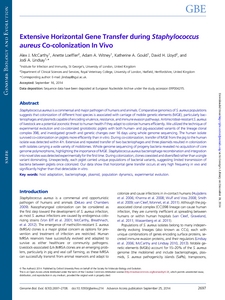McCarthy, AJ; Loeffler, A; Witney, AA; Gould, KA; Lloyd, DH; Lindsay, JA
(2014)
Extensive horizontal gene transfer during Staphylococcus aureus co-colonization in vivo.
Genome Biology and Evolution, 6 (10).
pp. 2697-2708.
ISSN 1759-6653
https://doi.org/10.1093/gbe/evu214
SGUL Authors: Gould, Katherine Ann Lindsay, Jodi Anne Witney, Adam Austin
![[img]](https://openaccess.sgul.ac.uk/107259/1.hassmallThumbnailVersion/Extensive_horizontal_gene_transfer.pdf)  Preview |
|
["document_typename_application/pdf; charset=binary" not defined]
Published Version
Download (1MB)
| Preview
|
Abstract
Staphylococcus aureus is a commensal and major pathogen of humans and animals. Comparative genomics of S. aureus populations suggests that colonization of different host species is associated with carriage of mobile genetic elements (MGE), particularly bacteriophages and plasmids capable of encoding virulence, resistance, and immune evasion pathways. Antimicrobial-resistant S. aureus of livestock are a potential zoonotic threat to human health if they adapt to colonize humans efficiently. We utilized the technique of experimental evolution and co-colonized gnotobiotic piglets with both human- and pig-associated variants of the lineage clonal complex 398, and investigated growth and genetic changes over 16 days using whole genome sequencing. The human isolate survived co-colonization on piglets more efficiently than in vitro. During co-colonization, transfer of MGE from the pig to the human isolate was detected within 4 h. Extensive and repeated transfer of two bacteriophages and three plasmids resulted in colonization with isolates carrying a wide variety of mobilomes. Whole genome sequencing of progeny bacteria revealed no acquisition of core genome polymorphisms, highlighting the importance of MGE. Staphylococcus aureus bacteriophage recombination and integration into novel sites was detected experimentally for the first time. During colonization, clones coexisted and diversified rather than a single variant dominating. Unexpectedly, each piglet carried unique populations of bacterial variants, suggesting limited transmission of bacteria between piglets once colonized. Our data show that horizontal gene transfer occurs at very high frequency in vivo and significantly higher than that detectable in vitro.
| Item Type: |
Article
|
| Additional Information: |
©The Author(s) 2014. Published by Oxford University Press on behalf of the Society for Molecular Biology and Evolution. This is an Open Access article distributed under the terms of the Creative Commons Attribution License (http://creativecommons.org/licenses/by/4.0/), which permits unrestricted reuse, distribution, and reproduction in any medium, provided the original work is properly cited. |
| Keywords: |
bacteriophage, experimental evolution, host adaptation, plasmid, population dynamics, Developmental Biology, 0604 Genetics, 0603 Evolutionary Biology |
| SGUL Research Institute / Research Centre: |
Academic Structure > Infection and Immunity Research Institute (INII) |
| Journal or Publication Title: |
Genome Biology and Evolution |
| ISSN: |
1759-6653 |
| Language: |
eng |
| Dates: |
| Date | Event |
|---|
| 1 October 2014 | Published |
|
| PubMed ID: |
25260585 |
 |
Go to PubMed abstract |
| URI: |
https://openaccess.sgul.ac.uk/id/eprint/107259 |
| Publisher's version: |
https://doi.org/10.1093/gbe/evu214 |
Statistics
Item downloaded times since 20 Jan 2015.
Actions (login required)
 |
Edit Item |



